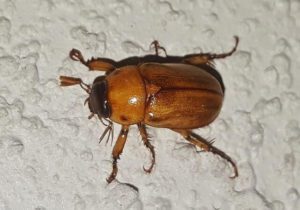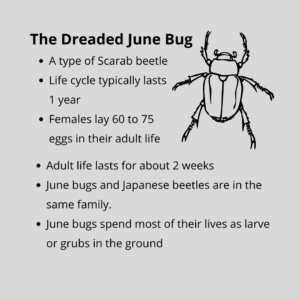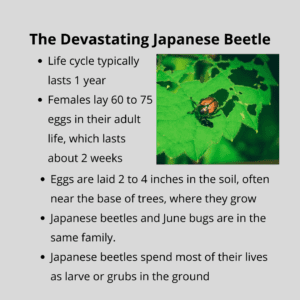Most people dread June bugs and Japanese beetles even though they are only adults for a short time. Learn more about these 2 leaf-eating pests and how they can cause other pests in your yard. We also explain how Done Right Pest Solutions has effective June bug control and Japanese beetle control methods.
Read on to learn all about June bugs and Japanese beetles, including the answer to, “What does a Japanese beetle look like?” Or, give us a call to talk to our customer service reps and get a free quote for Japanese beetle control or June bug control: 651-342-9489.
Table of Contents
- Life Cycle of June Bugs
- Life Cycle of Japanese Beetles
- Other Pest Issues These Bugs Could Cause
- How We Treat for These Bugs
- Conclusion & Next Steps
Life Cycle of June Bugs

Females lay 60 to 75 eggs in their lifetime But since adulthood only lasts about 2 weeks for June bugs, that is still a considerable number in that time frame. June bugs become adults in mid-summer, or around June as their name implies.
In 18 days, the eggs hatch into little white grubs, which molt twice quickly, shortly after hatching from their eggs.
Then, over the course of 9 months, they seek out food before they can molt the 3rd and final time
June bugs hibernate in the ground over winter as grubs and then come out in the spring and pupate a final time.
As older pupa, June bugs eats and finds their nutrients in soil. As adults, they consume large holes into leaves of trees.
Sometimes home owners misconstrue the pest eating the holes in their leaves, because June bugs and Japanese beetles both do this. They are in the same family.
For June bug control, whether preventative or reactive treatment, give Done Right Pest Solutions a call 651-342-9489!

I don’t know one person who likes June bugs, in fact, the internet is full of memes created by people who get it: June bugs are terrifying.
Life Cycle of Japanese Beetles

Females lay 20 to 40 eggs in their lifetime, though like June bugs, their adulthood lasts a couple of weeks in the summer.
Japanese beetles lay their eggs in the ground about 2 to 4 inches deep where, slowly, these eggs hatch and become grubs underground.
They molt and become bigger, hibernating underground for the winter, just like June bugs. Finally, Japanese beetles emerge in the spring as adults.
Japanese beetles appear metallic, with their bright, dark green bodies, and brown wings. Japanese beetles are among some of the more pretty beetles out there.
For Japanese beetle control, whether you had them last year or have them currently, give Done Right Pest Solutions a call at 651-342-9489!

Many often will use pheromone traps to target these beetles from destroying their trees. We would not recommend it. The etymology department at the University of Minnesota doesn’t recommend using pheromone traps either.
Using pheromone traps attracts not only more Japanese beetles to your yard but other insects as well. Research shows that while usually a large population of insects end up in the trap, more fly around the trap and end up in your yard than would have originally been there.
It is most effective to hire a pest control company for Japanese beetle control, and usually the earlier in the season or as soon as you notice them, the better.
Other Pest Issues These Bugs Could Cause
Because these grubs stay underground for the majority of their life, they aren’t predators or prey to many pests. But, what is one pest we know of that tunnels underground and eats grubs and worms?
Moles! Yes, if you have these beetle pests, moles could be attracted to your yard because they have this food source.
We also know that these beetles eat the nutrients in the soil and from the plants, roots, etc. that are in your yard. Chances are if you have Japanese beetles or June bugs in your yard, your yard is healthy!
But, we also know that voles are attracted to healthy yards and they like to eat the roots of grass and bulbs of plants.
Pests often cause other pests, so it is important to have a preventative pest control program in place for your home or rental property. Check out our Peak Seasons Plan for more information on our residential plan or read more on our Residential Pest Control page.
If you own a bunch of rental properties check out our Commercial Flyer for information regarding monthly or quarterly plans or read more on our Commercial Pest Control page.
How We Treat for These Bugs
Done Right Pest Solutions offers both a reactionary approach and preventative approach for these pests. The exterior treatments of homes and garages that we offer as a part of the Peak Seasons Plan will kill off both June bugs and Japanese beetles that land on these treated surfaces.
We also offer treatment of trees and around trees that have been or are affected by Japanese beetles or June bugs. Because these beetles lay eggs and spend most of their lives in the ground, usually at the base of trees, it makes it easier to treat them.
Our technicians will treat the base of the trees with a product that will sink down to the 2 to 4 inches where the grubs are located and kill them off so you can have a healthier and bug free yard the next year.
The product is not harmful to any trees or plants that we treat, but we strive to not treat anywhere near food-bearing plants and edible plants.
For other yard pests, check out this category within our blog.
Conclusion & Next Steps
Hopefully you have learned a bit about these nuisance pests that are harmful to trees and plants in your yards. Aside from being downright creepy when they land on your hair, these pests can devastate gardens and lawns.
You learned about the similar life cycles of these related bugs: June bugs and Japanese beetles, as well as what June bugs and what Japanese beetles look like. You also learned about other pests that may be attracted to your yard because of these pests. Unfortunately, the circle of life causes additional pests.
We described how we effective June bug control, Japanese beetle control and how both of these insects are included in our Peak Seasons Plan. You were given more information regarding residential properties and commercial properties.
We at Done Right Pest Solutions hopes that you will call us if you ever have any additional questions or concerns regarding these or other pests that are bugging you: 651-342-9489!
We look forward to helping you rid your yard of June bugs and Japanese beetles.
Done Right Team
Have you had your favorite tree look like a doily? Did you call an arborist, or what did you do? We’d love to hear from you in the comments!
Want to learn more tips and tricks regarding pest control? Subscribe to our free email newsletter.

